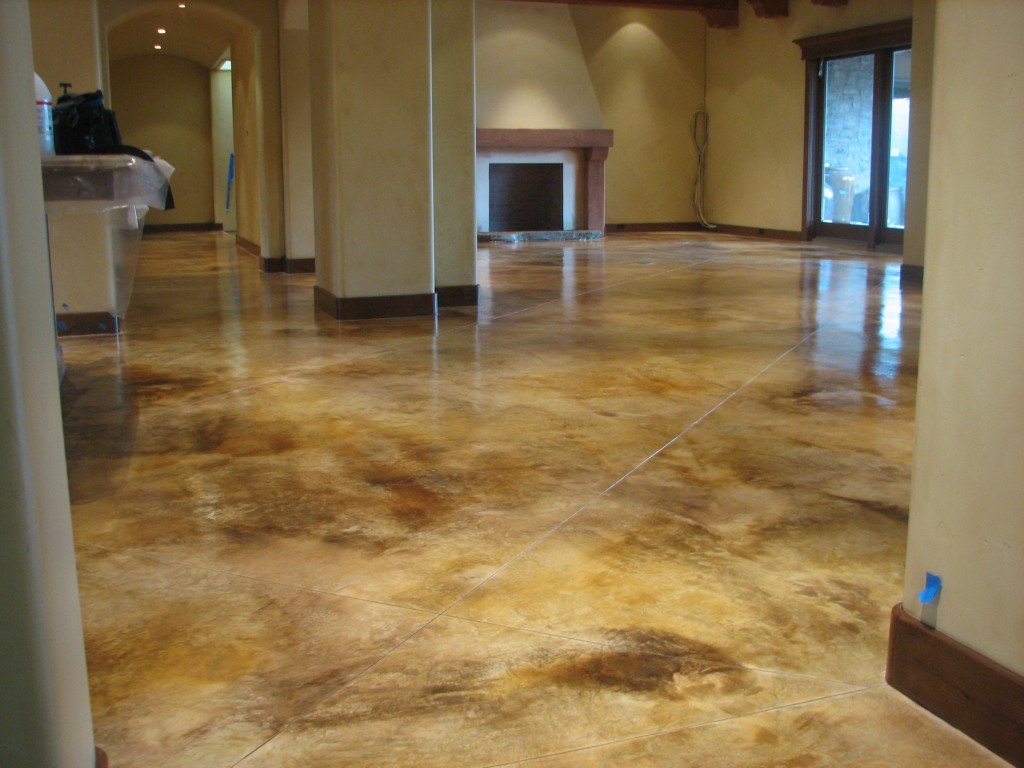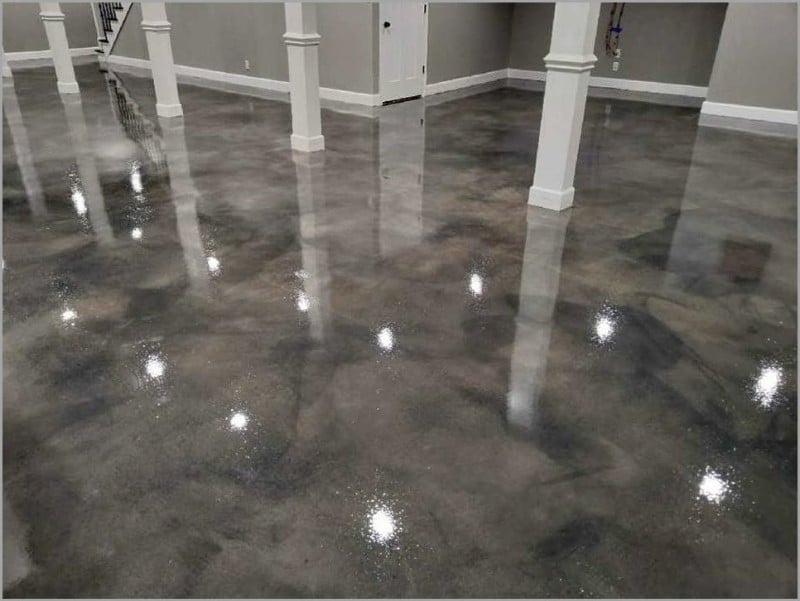Recognizing the Various Kinds Of Stained Concrete for Your Following Project
Stained concrete offers different alternatives that deal with various visual and functional demands. Each type provides unique features that affect the last appearance and durability of the surface. Comprehending these distinctions is vital for any individual intending a job. From rich, chemical reactions of acid-based stains to the dynamic harmony of solid color stains, the choices can greatly affect the outcome. What factors should one take into consideration when selecting the optimal stain for their particular demands?
Review of Stained Concrete
Stained concrete serves as a functional flooring option that can enhance the aesthetic charm of various spaces. This technique includes applying a coloring agent to the surface area of existing concrete, enabling for a wide spectrum of layout opportunities. Stained concrete is prominent in both domestic and business atmospheres, using a resilient and low-maintenance service that can resemble the appearance of natural materials like stone or tile.
The discoloration process can be executed using water-based or solvent-based items, each supplying unique visual impacts. The final appearance is affected by elements such as the initial concrete surface, the type of tarnish used, and the application technique. Stained concrete not only improves interiors and exteriors yet also advertises sustainability by rejuvenating existing concrete structures. Consequently, it has actually gained traction amongst property owners and designers looking for both capability and design in their floor covering choices.
Acid-Based Stains: Features and Advantages

Special Shade Variations
Concrete surfaces can change drastically with the application of acid-based stains, which offer an abundant scheme of one-of-a-kind color variations. These stains penetrate the concrete, responding chemically to create vibrant planet tones that vary from deep browns and reds to soft environment-friendlies and blues. The resulting shades are typically variegated, developing a natural, marble-like appearance that enhances the concrete's character. Each application yields unique results because of variants in the concrete's make-up and the discoloration strategy used, making every job distinct. Additionally, acid-based stains can be layered or integrated with other strategies to create personalized styles, permitting individual expression. This versatility makes acid-based stains a preferred option for both domestic and commercial applications.
Chain Reaction Clarified
While several aspects add to the efficiency of acid-based stains, the underlying chemical reactions play a crucial duty in their one-of-a-kind attributes and benefits. These stains primarily include water, acid, and metallic salts. When put on concrete, the acid responds with the calcium hydroxide in the concrete, producing a chemical transformation that results in irreversible shade changes. The metal salts penetrate the surface and bond with the concrete, enabling a broad range of hues and tones. This response not just boosts aesthetic charm yet additionally provides resilience, making the color immune to fading and wear. Additionally, acid-based stains can develop a variegated coating that resembles all-natural stone, more boosting their popularity for ornamental concrete applications.
Surface Area Prep Work Importance
Achieving optimal outcomes with acid-based stains rests on extensive surface preparation. This important action assurances that the concrete surface is tidy, devoid of pollutants, and properly profiled for suitable discolor absorption. Any existing sealants, dust, or oils can impede the chain reaction that creates the preferred shade and coating, resulting in irregular or uneven results.
Prior to using the tarnish, the concrete needs to be mechanically cleaned or stress washed, followed by a complete evaluation for cracks or flaws that may need repair. Additionally, validating the surface area is sufficiently dried will improve tarnish adherence. By focusing on these preparatory procedures, the longevity and vibrancy of acid-based stains can be considerably enhanced, causing a much more visually pleasing and resilient coating.
Water-Based Stains: Functions and Advantages

Water-based stains permeate the concrete, supplying an extra translucent surface that highlights the natural appearance and variations of the surface underneath. They are available in a large array of colors, permitting innovative versatility in design. Additionally, water-based stains are easier to clean up, requiring just water and soap, which simplifies the application process.
Their quick drying time enhances efficiency, making them a practical choice for both DIY fanatics and specialists. On the whole, water-based stains provide an enticing combination of aesthetic convenience and easy to use residential or commercial properties, making them a prominent alternative for concrete enhancement tasks.
Strong Shade Stains: Dynamic Options for a Vibrant Appearance
Solid shade stains use a reliable solution for those seeking to develop a vibrant and vivid visual on concrete surfaces. These stains supply an uniform coloration that can substantially enhance the visual charm of floorings, patios, and driveways. Available in a vast range of tones, strong shade stains enable innovative expression, providing to different layout choices.
One of the crucial benefits of solid color stains is their capacity to hide flaws, supplying a fresh and refined want to aging concrete - Stained Concrete Floors Austin Texas. In addition, their formulation typically includes UV-resistant buildings, making certain long life and shade retention even in harsh weather
Application is uncomplicated, calling for very little preparation of the concrete surface area. Once used, solid color stains can be sealed for address included defense and shine, further raising their aesthetic quality. With their vivid choices, strong color stains are an exceptional selection for those going for an impactful and natural layout.
Semi-Transparent Stains: Attaining Depth and Measurement
Semi-transparent stains supply an one-of-a-kind method to improving concrete surfaces by supplying depth and measurement with various shade options. Comprehending the application methods is vital for achieving the desired effect, while proper maintenance methods assure long life. This section will discover these key aspects to make best use of the benefits of semi-transparent discoloration.
Color Options Available
A variety of color alternatives exists for semi-transparent stains, allowing house owners and developers to boost the natural elegance of concrete surface areas. These stains can be found in a selection of colors, from earthy tones like browns and terracottas to vibrant colors such as blues and environment-friendlies. The semi-transparent nature of these stains enables the underlying concrete to reveal through, producing a special deepness and measurement that can enhance numerous layout aesthetics. Furthermore, incorporating different shades can produce custom-made shades, making it possible for a customized try to find each task. This adaptability makes semi-transparent stains a preferred choice for both exterior and interior applications, as they can balance with surrounding aspects while adding visual rate of interest to simple concrete.
Application Methods Described
To achieve the preferred deepness and dimension with semi-transparent stains, correct application techniques are vital. Initially, surface area preparation is crucial; the concrete should be clean and totally free of any type of contaminants. This usually includes power cleaning and repairing any fractures. Next off, selecting the right applicator, such as a sprayer, roller, or brush, can affect the final appearance. Sprayers enable an extra even application, while rollers can aid achieve appearance. It is necessary to apply the stain in thin, also layers, permitting each layer to completely dry prior to including another. Controling the application technique, such as differing pressure or using different tools, can create unique effects. Ultimately, securing the stained surface area enhances the vibrancy of the colors while offering security.
Upkeep Best Practices
Normal upkeep is crucial for preserving the appeal and honesty of surfaces treated with semi-transparent stains. To keep these surface areas, regular cleansing is crucial. Utilizing a pH-neutral cleaner and a soft-bristle mop will assist eliminate dust and debris without damaging the discolor. It is advisable to avoid extreme chemicals, as they can break down the discolor's appearance. Additionally, routine resealing every one to three years can secure versus wear and fading. This procedure includes cleaning the surface completely and applying a compatible sealer made for stained concrete. Property owners ought to likewise keep track of for any type of signs of staining or damages and address these issues immediately to assure lasting vibrancy and longevity. Following these ideal techniques will certainly improve the general life expectancy of semi-transparent stained surface areas.
Results and Techniques: Personalizing Your Stained Concrete
Tailoring stained concrete involves a range of methods that enhance both aesthetic appeals and capability. Among these approaches, layering various tarnish colors can develop depth and complexity, permitting special visual impacts. Techniques such as acid staining give a variegated appearance, while water-based stains offer an extra consistent look.
In addition, incorporating decorative patterns, such as stenciling or inscription, can even more individualize the surface area, adding detailed styles that satisfy specific preferences. Texturing the concrete, whether through stamping or broom coatings, presents tactile elements that not only improve hold but also boost visual interest.
Additionally, using sealants can amplify the shade vibrancy and supply protection against wear. Modification strategies prolong past mere color; they can change a typical concrete piece into a spectacular prime focus, making it appropriate for both domestic and industrial spaces. With mindful option of impacts and methods, stained concrete can accomplish a genuinely customized appearance.
Upkeep and Long Life of Stained Surfaces
Stained concrete surfaces my explanation are recognized for their durability and visual allure, maintaining their integrity is crucial for making certain durability. Routine cleansing is essential; sweeping and mopping with a pH-neutral cleaner helps prevent dust accumulation and staining. Additionally, applying a sealant every couple of years can secure the surface from dampness, chemicals, and UV damages, thus enhancing its lifespan.
It is also important to deal with any splits or chips promptly. Tiny repairs can mitigate more wear and tear, protecting the visual and architectural quality of the surface. For outdoor stained concrete, seasonal upkeep, such as getting rid of snow and ice, is needed to stop surface area damage from freeze-thaw cycles.
Regularly Asked Concerns
Can I Tarnish Existing Concrete Surfaces or New Ones?
The question of whether existing concrete surfaces can be stained occurs frequently. It is undoubtedly feasible to discolor both new and old concrete, supplied the surface area is appropriately prepared and devoid of impurities for excellent adhesion.
For how long Does the Discoloration Refine Commonly Take?
The discoloration procedure usually takes one to 3 days, depending upon elements such as surface preparation, sort of stain, and weather. Stained Concrete Floors Austin Tx. Healing time may prolong past preliminary application, affecting the general period substantially
Is Stained Concrete Safe for Outdoor Use?
Stained concrete is generally secure for outdoor usage, gave it is properly secured. find out here This sealing protects versus dampness and UV damages, guaranteeing resilience and safety and security, while likewise enhancing the aesthetic allure of outside spaces.
Can I Apply Several Stain Layers for Different Effects?
Using several tarnish layers can accomplish varied results on stained concrete. Nonetheless, it is necessary to guarantee compatibility between stains and enable correct drying time in between applications to stay clear of unintentional reactions or staining.
Are There Any Kind Of Shade Limitations for Stained Concrete?
Color constraints for stained concrete mainly depend upon the type of tarnish made use of, with water-based stains supplying a broader palette compared to acid-based stains. Stained Concrete Floors Austin Texas. However, accomplishing dynamic colors might call for cautious option and application strategies